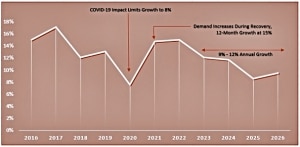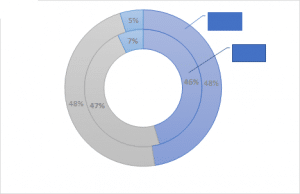Digital Pathology Gets Big
The global digital pathology market is valued at $866 million in 2021, consisting of hardware, software and related services for clinical applications. In 2020, markets experienced slowing demand early in the year due to reduced orders and budget freezes as the COVID-19 pandemic surged on over the year. The impact began to soften in the second half of 2020 and continued to gain during 2021.

Largely, the digital pathology market has benefitted from the COVID-19 pandemic, allowing pathologist to read, evaluate and collaborate remotely. Digital pathology will allow pathologists to improve efficiency and productivity.
In addition to digital microscopy the use of high-throughput, automated digital pathology scanners, laboratories can capture an entire glass slide (whole slide imaging, WSI), under bright field or fluorescent conditions, at a magnification comparable to a microscope. The slides are scanned using high resolution so that an analog image is being created. The scans are then digitized using a computer. The device identifies certain focal points in the tissue and scans them frame-by-frame. Digital data storage allows access to all desired scans or patient reports. A comparison of scans with archive images is possible at any time, but these images require very large storage capacity.
Digital slides can be shared over networks using specialized digital pathology software applications. Automated image analysis tools can also be applied to assist in the interpretation and quantification of biomarker expression within tissue sections.
The rapid progress of whole slide imaging (WSI) technology, along with advances in software applications, LIS / LIMS interfacing, and high-speed networking, have made it possible to fully integrate digital pathology into the pathology workflow. In short, WSI can and is revolutionizing tissue histology.
“Digital Pathology is valued at $866M with continued gains from 2020’s slowdowns. This is from Kalorama Information’s report, Digital Pathology Markets.”
Opportunity exists for the potential future use of digital pathology for quantitative analysis of emerging companion diagnostics. This opportunity may become especially relevant with the advent of assays which are difficult to discern with the human eye, such as multiplex, or markers which exhibit diffuse staining characteristics across multiple cellular compartments of which, for example, only one may be clinically relevant. The increasing complexity of such assays is driving the development of digital pathology solutions with advanced high-throughput image capture coupled with pattern recognition to morphologically identify relevant tissue types and individual cellular compartments followed by the ability to quantify (IHC) intensity of staining.
Drivers and Limiters to the Digital Pathology Market

Breakout of Digital Pathology Market. Details in report.
There are a number of drivers and limiters that influence the digital pathology market. Each of these continue to impact the market either positively or negatively.
Drivers
The most import drivers affecting the digital pathology market include:
- Affordable scanners
- Increased demand
- Rising disease prevalence along with an aging population
- Improved laboratory workflow, customization and productivity
- Telepathology implementation
- Continued automation of the lab and digitalization of healthcare
- Regulatory changes that benefit digital pathology.
Limiters
- Cost of implementing digital pathology solutions and ROI
- Technological infrastructure to support digital pathology
- Lack of skilled personnel
- Lack of physician education and interest to change
- Slow regulatory process
- Fragmented digitalization in clinical and lab sector
Many of these drivers and limiters have been present for many years but the pandemic helped to address some of these and there is renewed momentum to advance the market further. We have already seen many new entrants into the digital pathology software market and improving models to meet the needs. Radiology information technology is influencing digital pathology growth due to the increasing inclusion of pathology in enterprise imaging deals.

